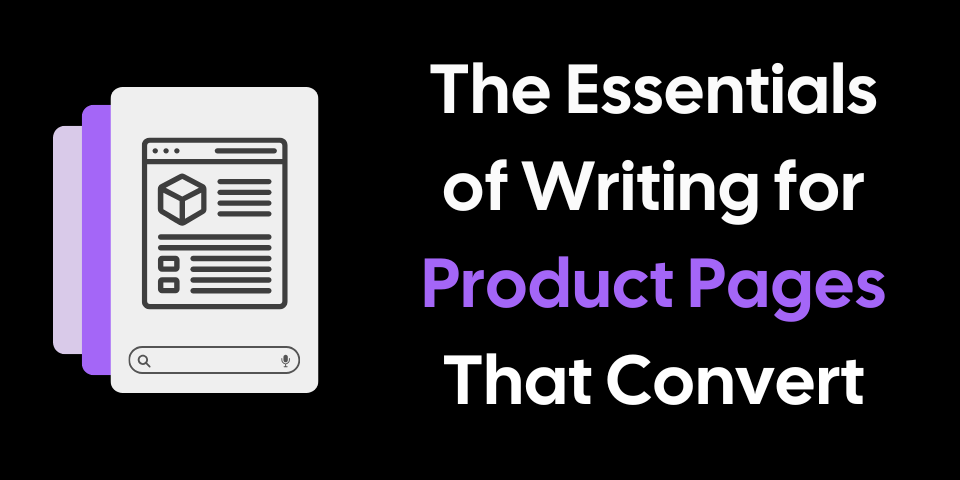
The Essentials of Writing for Product Pages That Convert
Introduction
Product pages succeed when they align with how the brain processes decisions. From trust-building cues to emotional triggers, every element shapes the buyer’s journey. Discover how to design pages that guide, engage, and convert seamlessly.
The Science Behind Conversion
The arrangement of information on a product page it’s designed to align with how the brain processes decisions.
When readers encounter elements like:
- Headlines
- Visuals
- CTAs
They subconsciously prioritize based on clarity, trust, and cognitive ease.
For example, chunking information into digestible sections reduces mental load, making the decision-making process feel simpler. Similarly, testimonials or data points early on establish trust, priming the reader to engage further.
Neurological triggers like scarcity, social proof, and immediacy can activate emotional responses that tilt decisions. A countdown timer might spark urgency, while a “bestseller” badge draws on social validation. The way this information is layered—starting with trust-building cues and transitioning into actionable benefits—determines whether a buyer clicks “Add to Cart” or hesitates.
Understanding these mechanisms allows writers to design product pages that subtly guide readers toward a confident decision.
Common Myths, Broken
Many product pages follow rigid formulas, but these templates often fail to consider nuances like audience intent or product complexity. Placing a CTA above the fold, for instance, assumes every visitor is ready to act immediately.
Yet for higher-value or complex products, visitors may need reassurance first. Positioning CTAs after detailed benefits can create a sense of earned trust, making the decision feel more deliberate and less pressured.
Similarly, while brevity works for impulse buys, longer descriptions can be essential for high-stakes purchases. A potential customer evaluating software or luxury items needs to see detailed explanations, comparisons, and proof of value before committing. Over-simplifying these pages risks alienating thoughtful buyers.
Writing for Experience, Not Just Sales
Effective product pages can create an experience that aligns with the customer’s values and emotions. Storytelling is a powerful tool here, transforming dry features into relatable benefits:
A fitness brand might describe how its product fits seamlessly into a morning routine, while a tech company might highlight a customer’s success story to frame its features in action.
Interactive elements like product quizzes or side-by-side comparisons further enhance the experience. They invite the user to actively participate, making the page feel personalized rather than transactional. Even humor or conversational tone, when used thoughtfully, can leave a positive impression, making the brand more memorable.
Ultimately, these pages resonate not because they push sales but because they reflect an understanding of the customer’s journey, helping them feel seen, understood, and confident in their choice.
The Dark Side of “Conversion Copy”
Optimizing for conversions can quickly become counterproductive when it undermines trust. Overuse of tactics like false urgency or over-promising results may boost short-term sales but can erode credibility over time. A countdown timer for a fake sale, for instance, can feel manipulative if repeated too often.
Authenticity is the antidote to these pitfalls. A transparent approach—acknowledging both strengths and limitations—creates a sense of honesty that resonates with skeptical buyers. So instead of overselling benefits, providing clear comparisons or stating, “This product is ideal for X but might not suit Y” can make the page feel refreshingly straightforward.
By balancing persuasion with integrity, customers are more likely to trust—and return to—a brand that respects their intelligence and gives them the tools to make informed decisions.
A Tactical Framework, Not Just Advice
Creating a high-converting product page requires a structured approach. Start by dissecting your audience’s intent. Are they looking for quick answers or comprehensive details? Understanding their mindset helps prioritize what to emphasize.
Next, organize content around a **hierarchy of trust**. Begin with elements that establish credibility, such as certifications or user testimonials. Gradually introduce detailed features, addressing potential objections with clarity. For example, a “Frequently Asked Questions” section can preemptively ease doubts, while industry-specific terminology can signal authority and expertise.
Finally, adapt tone and language to the audience. A playful, casual tone might work for lifestyle products but could feel out of place for professional services. By aligning the page’s voice with its audience, you create a cohesive narrative that feels tailored and trustworthy.
This framework ensures product pages inform and guide. At its core, this mirrors the backend logic of Tactical Post, which uses a similar structured approach to streamline the process for clients. By easing the burden of research and providing clear, well-organized instructions, it allows businesses to focus on what matters—connecting with their audience
In Conclusion…
Product pages present themselves as opportunities to connect with customers, build trust, and reflect the brand’s values. By combining psychological insights, creative strategies, and ethical persuasion, writers can craft pages that resonate deeply while driving results.
So, if you’re in search of a solution or manage product page descriptions, Tactical Post helps you get it done faster while ensuring professional-quality results. Get in touch to learn more.
Also, get to know our products better by purchasing our one-time payment option or try your first article for free!